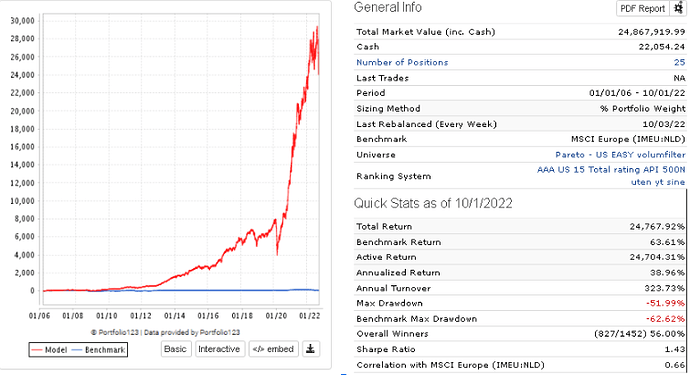Thank you for bringing up that subject!!!
While I am far away from automating my technical analysis on trading systems with “clean” factor weightings (value, quality, size, momentum etc.)
I put in 90% of my R&D Time into the TA approach combined with my trading systems.
-
The target of that approach is to first determine a risk on or risk off regime.
-
The second step is to determine the systems (that are loaded with clean factors / industries) that are “priced up” by the market, e.g.
that show relative strength and to be exactly in those (clean factor) systems if in a risk on market (and only be very lightly invested in a risk off market).
For that I put my cleanest factor 25 Systems (tons of variations of small cap value momentum, high beta (mid cap, big cap), industry-based systems (Oil, Materials, Healthcare, Tech), rank momentum systems), deep value (strong lately!!!) into one live book and put those stocks into TC2000 where I analyze those 150 Stocks in TC2000.
I than monitor the top 25 Stocks (4 Week Momentum for the bigger volume stocks, 3 Months Momentum for the small caps) technically and fundamentally.
Stuff like PRPH, DBTX, BOLT (all healthcare, my healthcare systems did very well the last 4 Weeks) and DQ (China, China Systems showed relative strength) came up in the last weeks.
Recent trading success came more from avoiding mistakes (I was long illiquid small cap value momentum from Feb-23June, hedged with a IWM Short and sold out to 100% cash on June 23 because Illiquid small cap momentum was losing relative strength) rather than making a big home run.
Up about 11% YTD, that is not much, but at least I avoided to be long high beta, crypto and lately out of inflation profiting illiquid small cap value momentum systems (since they started to show weakness, especially with the bad bounce on the recent market mini rally).
Not enough proof to know if this approach is valid, but the results are promising so far.
Also, I studied a ton of “star” traders that have a proven track record and match their approach to scientific papers.
What is very interesting, that those traders “front run” academics, e.g., that they are using frameworks years and years before academics catch up (happened on factor momentum and short term momentum (4 Weeks) on highly liquid stocks).
So, while I am more critical about academics now than I was, when I see an intersection of traders being successful trading one approach and academics seeing the same, I am very interested in that approach.
From what I can see what most successful traders use: Short term momentum (4 Weeks) on highly liquid stocks that show (Beta adjusted!) relative strength to the overall market. Also, they trade “hot” themes (not memes!), right now they concentrate on healthcare stuff, and they have been riding the energy stuff until lately.
Those traders are extremely flexible (and put in 60 hour++ weeks!!!), agnostic and do not care about the underlying idea or on the why. That does not mean they do not look at fundamentals, they do. But before they look at fundamentals the stock needs to be strong and show relative strength to the market.
They are very good at seeing general market risk.
Also, what I was seeing the last 2 Years: Most investors simply got lucky with their approach (high beta, crypto investors in 2020/2021 or long inflation in 2021 until recent), they fall in love with their thesis and do not change when the market in not “pricing up” the factor exposures they are in love with.
When sentiment gets hot on twitter and arguments against their thesis gets answered with “calling names” that means something. The disbelieve of high beta investors, crypto investors was astronomical when we called out at the beginning of December that this trade is over (since even the strongest high beta systems showed extremely weak relative performance). Same happens now with long “inflation” (Oil, Commodities etc.) investors.
[Of cause there is the valid approach to be a longer term trader investor and simply choose factors that do well on average (like illiquid small cap value momentum) and ride out the DDs, not everybody can put in 60 hour+ weeks!].
But I am to much spirited by high performance traders and on what they do (esp. their flexibility and agnostic approach), therefore the heavy R&D in factor momentum and technical analysis of capital curves and then TA (and fundamental analysis) of stocks out of those strongest systems while having a good risk on / risk off approach concerning the general market.
I am pretty excited about that stuff!!!



